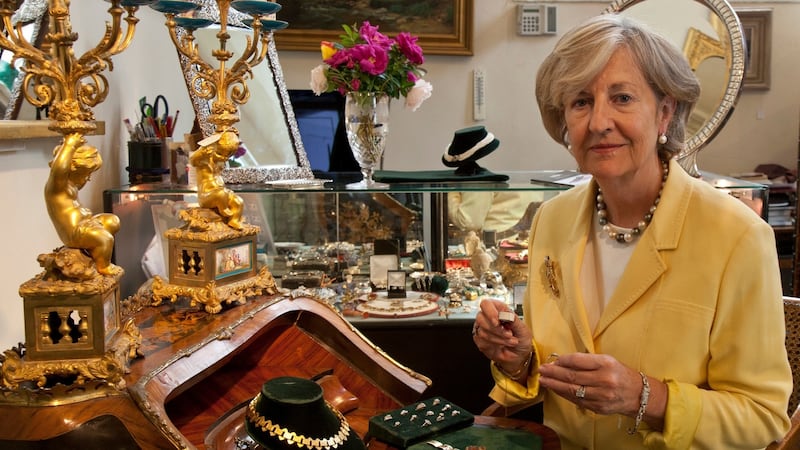Gráinne Pierse runs Courtville Antiques in the Powerscourt Townhouse Centre in Dublin specialising in the sale of diamond engagement rings and Georgian, Victorian, Edwardian, and art deco jewellery. She took over the business from her mother, Catherine Pierse (96) who founded it, in August 1964, in Tipperary town in a small chalet in the grounds of her home. Courtville Antiques was a founding member of the Irish Antique Dealers Association (IADA) and of the 15 exhibitors at IADA's first fair at the Mansion House in Dublin in 1966, is one of only four still trading 50 years later.
What’s your background?
I grew up in Tipperary town, one of seven children. My mother has impeccable taste and a lifelong passion for antiques, and I became immersed in the excitement of the business while still a schoolgirl. I remember watching her polishing silver and brass and accompanying her to auctions in big country houses. It was a superb education, as was assisting her at the first IADA fair. I went to boarding school at the Dominican Convent in Wicklow and then studied history of art, French, Spanish and music at Trinity College, Dublin, and completed a higher diploma in education. I travelled to Paris to teach and attended auctions at the famous Hôtel Drouot. I worked in Bond Street and Portobello Road in London, learning the trade at first hand from a number of antiques dealers and attended courses run by the Gemmological Association, the world authority on diamonds and coloured stones.

How did you get into the business?
In 1981, having returned to Ireland, my mother and I opened the shop in the then recently-restored Powerscourt Townhouse Centre. We kept the Tipperary town shop going for a few years until it became too complicated to run both. The early days of the business in Dublin were exciting, yet challenging, with a scarcity of Irish customers during the recession of the 1980s. Public interest in antiques was not what it is today; there wasn’t much money around and we relied mainly on American buyers who travelled to Ireland to purchase antiques. I decided to specialise in antique jewellery, diamond engagement rings with unusual cuts such as the antique cushion-cut and the Asscher-cut which was developed by the Asscher brothers in the Netherlands in 1902. Old and unusual pieces are hard to come by nowadays, and I travel widely to source quality goods, often holding on to a particular piece for a year or more before I find the right buyer.
Career highlights?
In 1966, when I was helping my mother at the IADA fair in the Mansion House, one of our customers was an American, Henry Francis du Pont [a member of one of America’s richest families who died in 1969]. He was a connoisseur and an avid collector of antique furniture and decorative arts for his home, Winterthur, in Delaware. It subsequently opened as the Winterthur Museum. At the fair, du Pont bought a set of Regency bookends from us. Prior to his death in 1969, he wrote a charming letter to Mum thanking her. About eight years ago, the directors of the Winterthur Museum came to Ireland and bought an antique Berlin iron bracelet dating to circa 1830 from me. It was a remarkable example of continuity in the antiques trade.
What advice would give to collectors or investors?
Having been involved in the business for more than 50 years since childhood, I’ve noticed the Irish market has become more sophisticated, buyers are more knowledgeable and there is more interest in, and demand for, antique jewellery. After a decade of domination by diamonds, there is now a growing appreciation of the subtlety and beauty of natural unheated and untreated coloured stones, particularly sapphires, rubies and emeralds. Natural pearls – increasingly rare – are also a good investment. Taste and trends change , but I believe that high-quality antique jewellery never goes out of fashion and remains highly collectable, desirable and wearable, as well as fascinating: every piece of antique jewellery has its own story to tell. At the moment, art deco jewellery is particularly sought-after – especially geometric brooches. Rare Georgian jewellery is also very collectible.
What do you personally collect?
I enjoy collecting miniature antiques, whose intricacy and skill of craftsmanship I highly admire. I also have a small collection of mourning jewellery. The craftsmanship, beauty and poignancy of specially-commissioned pieces draw me into a moment in the past. One ring in my collection commemorates the death of Lady Elizabeth Anderson on April 9th, 1769. For me it personalises a moment in the 18th century.
What would you buy if money were no object?
A Georgian house – preferably in Co Wicklow – which I’d fill with 18th century furniture, paintings and silver.
What is your favourite work of art and why?
The doll's house of Petronella Oortman in the Rijksmuseum, Amsterdam. Oortman was a wealthy Dutch widow whose second marriage was to a silk merchant, Johannes Brandt. Her doll's house was probably made between 1686 and 1690, while its furnishings took another 15 years to complete. An original painting by Dutch artist Jacob Appel of the house, circa 1700, shows it completely intact then – as it is today. At that time, dolls' houses were made for wealthy women, rather than for children, and Petronella spent between 20,000 and 30,000 guilders on the house which is filled with fragile objects – all in miniature and extremely true-to-life – made of porcelain, ivory, silver, glass, textiles and basketry – and representing the combined efforts of many skilled craftsmen: painters, sculptors, cabinet-makers, silversmiths, upholsterers and glassblowers. It provides invaluable information about Dutch life in the late 17th century. I find it breathtakingly beautiful and exciting in its re-enactment of everyday life and it is well worth a visit to the Rijksmuseum to see it.
See courtvilleantiques.com
In conversation with Michael Parsons













